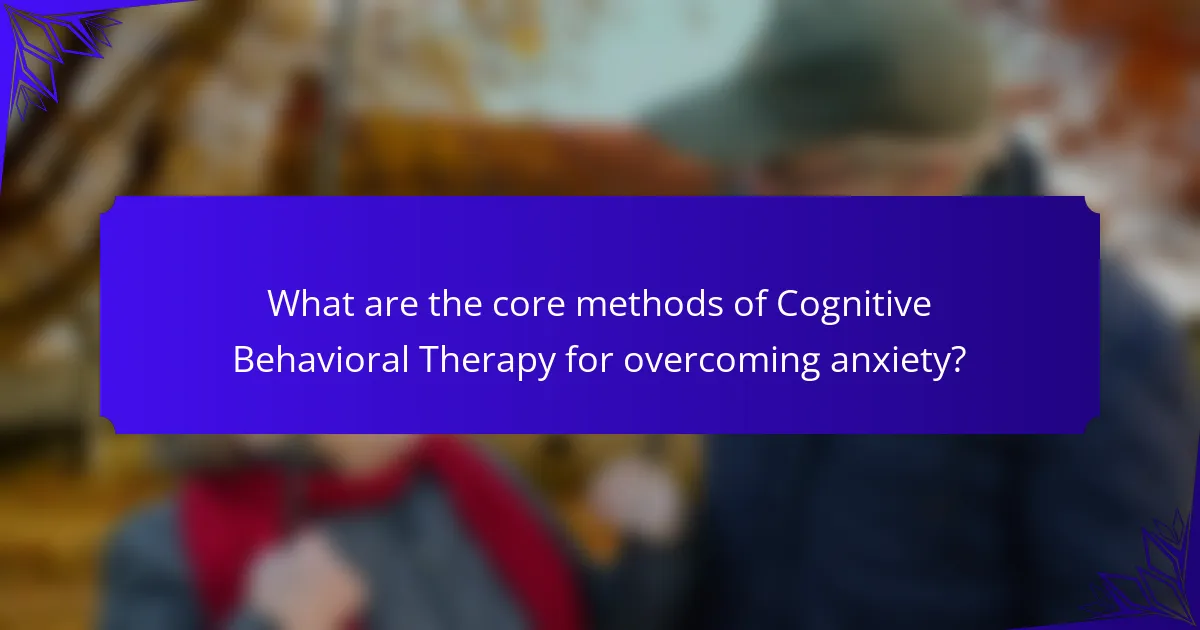Overcoming anxiety is crucial for personal well-being and relationship success. Cognitive Behavioral Therapy (CBT) offers effective methods such as cognitive restructuring, exposure therapy, and behavioral activation. These techniques build resilience by promoting adaptive thinking and emotional regulation. Additionally, CBT enhances relationships through improved communication strategies and positive interactions.

What are the core methods of Cognitive Behavioral Therapy for overcoming anxiety?
Cognitive Behavioral Therapy (CBT) utilizes several core methods to effectively overcome anxiety. These methods include cognitive restructuring, exposure therapy, behavioral activation, and mindfulness techniques.
Cognitive restructuring helps individuals identify and challenge negative thought patterns, enabling them to replace irrational beliefs with more realistic ones. Exposure therapy gradually exposes clients to anxiety-provoking situations, reducing fear responses over time. Behavioral activation encourages engagement in meaningful activities to combat avoidance behaviors associated with anxiety. Mindfulness techniques promote present-moment awareness, reducing rumination and fostering emotional regulation.
Together, these methods build resilience and enhance interpersonal relationships by equipping individuals with practical tools to manage anxiety effectively.
How does Cognitive Behavioral Therapy help in managing anxiety symptoms?
Cognitive Behavioral Therapy (CBT) effectively manages anxiety symptoms by altering negative thought patterns. CBT equips individuals with practical skills to challenge irrational beliefs, fostering resilience. Techniques such as exposure therapy and cognitive restructuring help reduce avoidance behaviors. Research indicates that 60-80% of individuals experience significant symptom relief through CBT.
What role does cognitive restructuring play in anxiety treatment?
Cognitive restructuring significantly reduces anxiety by challenging negative thought patterns. This method helps individuals identify irrational beliefs and replace them with more balanced thoughts. As a result, patients experience decreased anxiety symptoms and improved emotional regulation. Research shows that cognitive restructuring enhances coping strategies and resilience, making it a vital component of cognitive behavioral therapy.
What are the steps involved in cognitive restructuring?
Cognitive restructuring involves several key steps to help individuals identify and change negative thought patterns.
1. Identify negative thoughts.
2. Challenge the validity of these thoughts.
3. Replace them with more balanced, realistic thoughts.
4. Practice new thought patterns regularly.
5. Monitor the impact on emotions and behaviors.
How can exposure therapy be effectively utilized in anxiety management?
Exposure therapy effectively reduces anxiety by gradually exposing individuals to feared stimuli. This method allows patients to confront their fears in a controlled environment, leading to desensitization. Research shows that exposure therapy can significantly lower anxiety levels, with studies indicating a success rate of up to 90% for specific phobias.
The process typically involves several steps: identifying the fear, developing a hierarchy of exposure scenarios, and gradually working through these scenarios. This structured approach builds resilience and enhances coping strategies. Additionally, combining exposure therapy with cognitive behavioral techniques can further improve outcomes by addressing negative thought patterns associated with anxiety.
Regular practice and support during exposure therapy are crucial for long-term success. Patients often report increased confidence and improved relationships as they learn to manage their anxiety effectively.
What techniques are used in behavioral activation for anxiety?
Behavioral activation techniques for anxiety focus on increasing engagement in positive activities. These methods include identifying avoidance behaviors, scheduling enjoyable activities, and using mindfulness to enhance present-moment awareness. Techniques like activity monitoring help track moods and reinforce positive behaviors. Cognitive restructuring assists in challenging negative thoughts linked to anxiety.

What are the unique attributes of Cognitive Behavioral Therapy in building resilience?
Cognitive Behavioral Therapy (CBT) uniquely enhances resilience by promoting adaptive thinking patterns. Key attributes include cognitive restructuring, which helps individuals identify and challenge negative thoughts, and exposure techniques that build coping strategies. These methods lead to improved emotional regulation and increased confidence in facing stressors. Additionally, CBT’s structured approach fosters a sense of control and agency, essential for resilience-building.
How does Cognitive Behavioral Therapy foster resilience in individuals?
Cognitive Behavioral Therapy fosters resilience by equipping individuals with practical skills to manage anxiety and stress. It emphasizes changing negative thought patterns, which enhances coping mechanisms and emotional regulation. This process helps individuals develop a stronger sense of self-efficacy, enabling them to face challenges more effectively. Additionally, CBT encourages the formation of supportive relationships, further reinforcing resilience through social connections.
What specific strategies are employed to enhance resilience through therapy?
Cognitive Behavioral Therapy (CBT) employs several strategies to enhance resilience. These include cognitive restructuring, exposure therapy, mindfulness techniques, and skills training.
Cognitive restructuring helps individuals identify and challenge negative thought patterns, promoting a more balanced perspective. Exposure therapy gradually confronts fears, reducing anxiety and building confidence. Mindfulness techniques encourage present-moment awareness, fostering emotional regulation. Skills training equips individuals with coping mechanisms to handle stress effectively.
These methods collectively strengthen resilience, enabling individuals to navigate challenges and improve relationships.
What role does goal-setting play in building resilience?
Goal-setting is crucial for building resilience as it provides direction and purpose. It helps individuals focus on achievable objectives, enhancing their ability to cope with challenges. Setting specific, measurable, achievable, relevant, and time-bound (SMART) goals fosters a sense of accomplishment, which strengthens self-efficacy. This process promotes adaptive coping strategies, enabling individuals to navigate stress more effectively. Research indicates that goal-setting enhances emotional regulation, contributing to overall mental well-being.
How does Cognitive Behavioral Therapy address negative thought patterns related to resilience?
Cognitive Behavioral Therapy (CBT) effectively addresses negative thought patterns by identifying and challenging irrational beliefs. This method enhances resilience by promoting adaptive thinking and coping strategies. CBT teaches individuals to reframe negative thoughts, fostering a more positive outlook and emotional regulation. As a result, clients experience improved mental health and strengthened relationships.

What rare attributes of Cognitive Behavioral Therapy enhance relationships?
Cognitive Behavioral Therapy (CBT) enhances relationships through unique attributes such as personalized communication strategies and cognitive restructuring techniques. These methods foster empathy and understanding, allowing individuals to navigate conflicts more effectively. Additionally, the focus on behavioral activation encourages positive interactions, which can strengthen emotional bonds. These rare attributes contribute to long-lasting relationship improvements by promoting healthier patterns of thought and behavior.
How can Cognitive Behavioral Therapy improve interpersonal relationships?
Cognitive Behavioral Therapy (CBT) can significantly enhance interpersonal relationships by addressing negative thought patterns and improving communication skills. CBT helps individuals identify and change unhelpful beliefs, fostering healthier interactions. As a result, it promotes empathy, reduces misunderstandings, and builds trust in relationships. Studies show that individuals who engage in CBT report improved relationship satisfaction and better conflict resolution skills. These benefits stem from CBT’s focus on self-awareness and emotional regulation, essential components for successful relationships.
What unique communication techniques are taught in Cognitive Behavioral Therapy?
Cognitive Behavioral Therapy teaches unique communication techniques like active listening, assertive communication, and reframing negative thoughts. These methods help individuals articulate feelings, express needs clearly, and shift perspectives for better emotional regulation. Active listening fosters understanding, while assertive communication promotes healthy boundaries. Reframing aids in transforming anxiety-provoking thoughts into constructive ones, enhancing resilience and interpersonal relationships.
How can assertiveness training be integrated into therapy?
Integrating assertiveness training into therapy enhances Cognitive Behavioral Therapy methods. This approach helps clients develop communication skills, set boundaries, and express needs effectively. Techniques include role-playing, guided discussions, and self-reflection exercises. These methods promote resilience and improve relationships by fostering confidence and clarity in interpersonal interactions. As a result, clients can manage anxiety more effectively and navigate social situations with greater ease.
What are the less common strategies for resolving conflicts using Cognitive Behavioral Therapy?
Less common strategies for resolving conflicts using Cognitive Behavioral Therapy include role reversal, where individuals adopt the perspective of the other party, and guided imagery, which involves visualizing positive outcomes. Additionally, using paradoxical interventions can help by encouraging clients to engage in the very behavior they wish to change, thereby revealing underlying motivations. These methods enhance emotional awareness and foster empathy, ultimately contributing to healthier relationships.

What are the best practices for implementing Cognitive Behavioral Therapy methods?
To effectively implement Cognitive Behavioral Therapy methods, focus on structured techniques and consistency. Establish clear goals, maintain a regular schedule for sessions, and utilize cognitive restructuring to challenge negative thoughts. Incorporate behavioral activation to encourage engagement in positive activities. Regularly review progress to adjust strategies as needed, fostering resilience and enhancing relationships.
What common mistakes should be avoided when using Cognitive Behavioral Therapy for anxiety?
Common mistakes to avoid when using Cognitive Behavioral Therapy for anxiety include neglecting to practice techniques regularly, overlooking the importance of a strong therapeutic alliance, and failing to set realistic goals. Additionally, patients may misinterpret cognitive distortions or become discouraged by slow progress. Lastly, not addressing underlying issues can hinder overall effectiveness.
How can individuals optimize their Cognitive Behavioral Therapy experience for better outcomes?
To optimize Cognitive Behavioral Therapy (CBT) experiences, individuals should actively engage in the process. Setting clear goals enhances focus and direction. Regularly practicing techniques learned in therapy, such as cognitive restructuring and exposure exercises, can reinforce skills. Maintaining open communication with the therapist fosters a supportive environment for discussing challenges. Tracking progress through journaling helps identify patterns and areas for improvement. Lastly, applying CBT strategies in real-life situations builds resilience and strengthens relationships.


